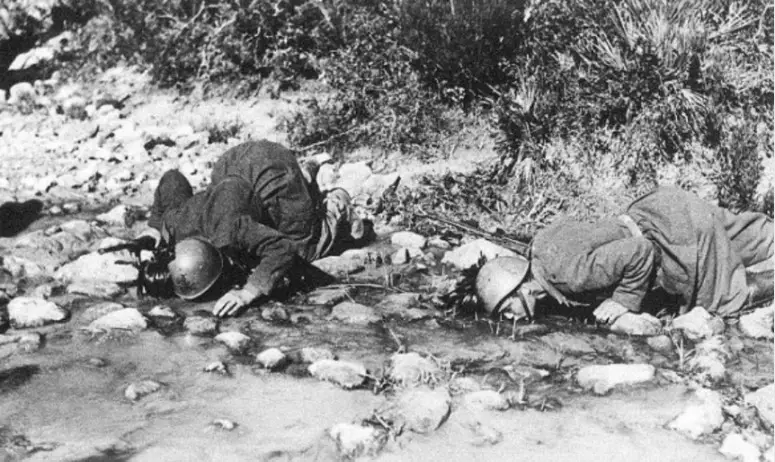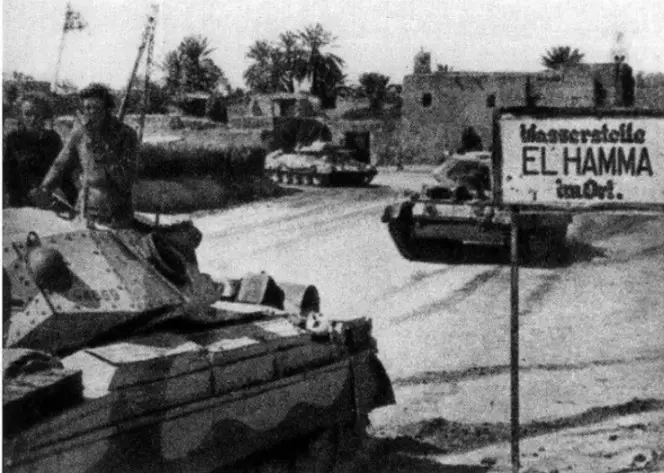
After the Battle of Mareth, the resistance of the Italian 1st Army was broken at Wadi Akarit, retreating then to North Tunisia, for the final chapter of the Tunisian campaign
The situation gets worse
After the retreat from the Mareth line, and thanks to the rearguard action near El Hamma, General Messe’s first Army was able to disengage the British 8th Army and redeploy along the so-called Wadi Akarit line (2930th March 1943). This was a new defensive position which had been considered back in January as an alternative fall-back line for Rommel’s forces retreating from Libya.

British tanks entering El Hamma
The Italians spent a great effort in fortifying the line and digging anti-tank ditches, from the coastal in the east to the Chott El Fedjadj salt flats to the west. The new line was only 24km wide, and although could benefit from the steep hills overlooking Wadi Akarit (a small river), there were some large plain gaps which could have been exploited by Montgomery’s armoured units.
From West to East, the Italian and German forces that manned the defences, were the Saharan Group, German 164. leichte-Division, Italian divisions ‘Pistoia,’ ‘Spezia,’ and ‘Trieste.’ Luftwaffe’s 19. Flak-Division provided support, with 15th Panzer-Divisions in reserve. These units were obviously not at full strength, since they had fought hard at Mareth and El Hamma in the days before.
To the North-West, the presence of General Patton’s II corps had created a lot of concerns, especially in the last days of the Battle of Mareth, since the eventual American breakthrough could have trapped the Italian 1st Army. To counter them, the Axis forces had moved the 10th and 21st Panzer divisions, to reinforce the Centauro division at El Guettar.
On March 30, the X Corps of the British 8th Army encountered Wadi Akarit’s defences. Suggestions of an immediate attack were dismissed by Montgomery in favour of a set-piece strategy, anticipating the enemy’s withdrawal under overwhelming strength. The assault plan involved XXX Corps (50th, 51st divisions and the 4th Indian division) breaking the line, followed by an armoured push to the north.
Battle and pursuit
The attack began in the early morning of the 6th of April, with intensive air and artillery support. The sector where the 8th army concentrated the push, was the central area held by the Trieste and Spezia divisions. Fierce fights raged for the entire morning and afternoon, but the 8th army managed to create some bulges in the Axis line. The situation of the Spezia division was particularly fragile since it had suffered the onslaught of two enemy divisions. It was estimated that XXX Messe ordered some counterattacks launched by the 15th Panzer and 164th Leichte divisions but by the end of the afternoon, everybody realized that the Army could not resist for another day and avoid complete destruction.
At 8 PM, in agreement with Von Arnim, Messe ordered the retreat to the Enfidaville line, 250km to the north. Around 7,000 Axis troops were killed or captured, while the 8th Army suffered 1,289 casualties. The 1st Army managed to pull out but it was severely battered.

Italian marines and German soldiers in southern Tunisia
The Spezia division was reduced to the size of a company, the Tireste division remained with 3 shattered battalions also the Pistoia and 90° leichte were severely weakened. Several artillery pieces were also lost, due to the absence of sufficient towing vehicles. The mobile forces guarding the Americans formed the rear guard of the retreating 1st Army and overall the Allies failed to impede the Axis retreat to the north and trap Messe in southern Tunisia.
The end approaches
In the north, the British First Army under General Anderson intensified pressure against the 5th Panzer Army, while the US II Corps was shifted to the north coast, sparking some discontent among the Americans.
By the 12th of April, all main Axis formations had reached the Enfidaville area. Allied forces captured Sousse and finally, the 8th and 1st Army linked up for the first time, setting the stage for the final drive on Tunis. The Axis-controlled area was becoming a smaller and smaller bridgehead that could be easily ravaged by Allied air superiority before the land units could finish the job. The supply stream from Italy was progressively decreasing due to the losses, but also the reduced availability of men and equipment (especially from the Italian side). Just in April, of the 3,426 men who departed from Italy, only 2,617 arrived while only 58% of the shipped supplies landed in Tunisia. General Messe and Von Arnim understood their days in North Africa were about to end, but despite the reality of the situation, somebody in the high spheres failed to understand the situation.
Mussolini meets Hitler
On the 7th of April, Mussolini met Hitler in Austria to discuss the current (dire) situation and the countermeasures to adopt. The position of Italy was becoming more and more fragile, since the country had exhausted almost all its energies in Africa and Russia, the industry could not keep up with the losses and the Allied material superiority. Mussolini wanted Hitler to sue for peace with the Soviets, in order to divert the focus to the western allies in the Mediterranean. With the imminent loss of North Africa, Italy was threatened by invasion and the country could hardly defend itself unless a decisive German help would have come. If this condition was not met, Italy would have re-evaluated its position within the Axis pact.
In theory, this was the argument that Mussolini should have brought before Hitler. However, once again, the Duce was unable to win an argument with the Führer and did not want to listen to any prospects of peace with the Soviets. On the contrary, he reaffirmed his belief that Tunisia would have resisted, while his upcoming summer offensive in the East would have solved the situation.
With Hitler failing to understand the reality of the situation, the drift between Germany and Italy finally commenced, leading up to the fatal events of the second half of 1943.
Sources
Ford, K. (2012) The Mareth line 1943, Osprey publishing
Montanari, M. (1989). Le operazioni in Africa settentrionale, Volume IV: Enfidaville (Parte prima). Roma: Ufficio storico dello stato maggiore dell’esercito.
Jowett, P. (2019). L’esercito italiano nella seconda guerra mondiale. LEG edizioni.
